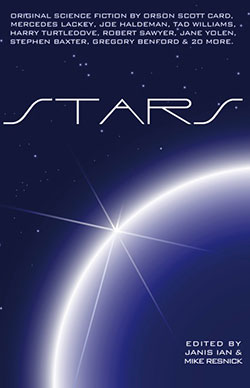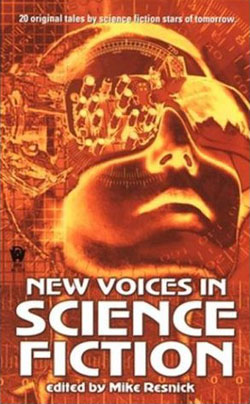
Those who grew up listening to Janis Ian's folk songs might be surprised at her secondary career.
Reassessing Janis Ian: 1970s Folk Icon, Modern-Day Sci-Fi Queen
You probably know Janis Ian from her five-decade folk legacy — not from her short stories about spirit possession and intergalactic sex spies.
But Ian, the singer and songwriter behind the 1975 Grammy-winning hit “At Seventeen,” also writes sci-fi. She’s attended at least one Worldcon, published stories in compilations edited by Mike Resnick and Tamora Pierce and, in 2003, helped assemble an anthology of stories by Hugo and Nebula award-winning authors based on her own songs.
When she performs in the Bay Area this coming week, she’ll probably be singing, not reading, and her lyrical contributions to folk history’s more radical side are reason enough to attend. Over the last 50 years, she’s covered domestic violence, incest, teenage body alienation and even rape culture (in 1967, at that, when hashtags were still just number signs), taking many a nuanced look at the politics surrounding girls’ bodies, and the ways those politics are internalized.
EVENT INFORMATION
Janis Ian & Tom Paxton
APR. 22, 2015
APR. 25–26, 2015
In other words, her music matters. But so does her sci-fi. And a strange symmetry comes from pairing her songs with the stories she’s written and edited, which also take on power dynamics and sexuality but feature ghost boyfriends and digital purgatories full of stairs.
Take “His Hands,” from her 1993 album Breaking Silence. A mixture of soft vocals and dangerous, grinding-in-a-dive-bar-at-2am guitar swing, the song pulls you in then shoves you away, building tension through the narrator’s ambivalence.
“His hands, they never hit me sober,” she sings. “His hands, they never marked my face.”
It’s a complex, defiant look at abuse that both condemns the unnamed “he” while humanizing him, revealing that she loved him, that she left him and that he, too, had once been a victim. You probably wouldn’t expect it to inspire a story about a planet-hopping sociopath forced to undergo a sex change. But it did: Ian’s “Second Person Unmasked,” which appears in the anthology Stars: Original Stories Based on the Songs of Janis Ian.
 The “he” in that story (written, effectively, as “you”) carries a spring-loaded double switchblade, wears a belt with a sharpened buckle and has a high forehead, which in Ian’s words has “don’t-fuck-with-me written across it in lines that took decades to accumulate.” He’s an obvious predator — a literal lady killer — and from his homophobia to his conquistador walk, he’s easy to hate.
The “he” in that story (written, effectively, as “you”) carries a spring-loaded double switchblade, wears a belt with a sharpened buckle and has a high forehead, which in Ian’s words has “don’t-fuck-with-me written across it in lines that took decades to accumulate.” He’s an obvious predator — a literal lady killer — and from his homophobia to his conquistador walk, he’s easy to hate.
But then, when two blonde girls with silver necklaces seduce him, trap him, and ship him off in a cargo freighter; when he’s sold into slavery, re-educated, starved and then changed into a sociopath-trapping girl himself, you start to pity him. Not really — “he” was terrible, even if “she” isn’t — but the story plays with your initial repulsion. Like the song, it takes a hard look at both the cyclical nature of abuse and the structural links between gender hierarchy and violence.
Or take what is probably Ian’s most well known song, “At Seventeen.” Post-30 Rock, when a drunk Liz Lemon did karaoke to the song and someone from the crowd heckled “You’re bumming us out!,” it’s easy to dismiss the sad-sack anthem everyone knows so well: “I learned the truth at seventeen / That love was meant for beauty queens.” But though the song’s ubiquity makes it feel dated, it’s about more than being, in Ian’s words, one of the “ugly duckling girls.” It’s a deep look at the very concept of prettiness — the sexism and racism folded into who, exactly, defines it; the fact that it can control your life.
 Janis Ian’s 1975 album Between the Lines, which featured “At Seventeen.”
Janis Ian’s 1975 album Between the Lines, which featured “At Seventeen.”And in Stars, it inspired a story about a supernatural suicide pact.
Written by Terry Bisson, the story is called “Come Dance With Me,” and opens with a boy and girl standing on a metal desk tying nooses around each other’s necks.
They’re trying to enter The Realm, an afterlife seen only by performing a specific ritual: Sit down at your computer, turn on repetitive music (preferably with the same four chords over and over), type in a secret URL, hit return, enter the user name you’re prepared to use for all eternity, and type the password: Kevork. When you see The Realm from this side it’s all stairs, no floor, no ceiling, and it looks so decadent that “even the shadows are gold.”
But that’s just to see it. To enter, you have to die.
The story follows Amaranth, the girl, and her futile attempts to get there. When she finally does, briefly, before being whisked out by paramedics, it’s grey, full of concrete instead of gold, and although she can still whisper, she’s lost her voice. It’s obviously a departure from the details of Ian’s hit (which mentioned neither suicide nor secret URL) but it feels the same. It feels like self-devaluation for a disembodied ideal; like the bulimia that myself and so many of my friends struggled with at Amaranth’s age; like the anxious buzzing that comes with willing yourself to take up less and less space. It feels like being a teenage girl.
 And those are only two stories — one written by Ian, one inspired by Ian. She’s also written about sister wives on a planet with two moons (Mahmoud’s Wives) and spirits who can possess bodies, but can’t control hearts (Eli and the Dybbuk). The anthology she helped compile contains a temporary apocalypse, a high-school reunion and a sad mermaid with scales like feathers, “so light-colored they all but disappeared into the green-gold skin.”
And those are only two stories — one written by Ian, one inspired by Ian. She’s also written about sister wives on a planet with two moons (Mahmoud’s Wives) and spirits who can possess bodies, but can’t control hearts (Eli and the Dybbuk). The anthology she helped compile contains a temporary apocalypse, a high-school reunion and a sad mermaid with scales like feathers, “so light-colored they all but disappeared into the green-gold skin.”
Bottom line: If you’re a Janis Ian fan, you should read her sci-fi. Here’s a comprehensive list with links. Her complex, controversial songs are an indispensable part of the folk cannon, and the weird stories they’ve inspired don’t just deepen and complement them — they do it with spaceships, micro-gravity and haunted phones.